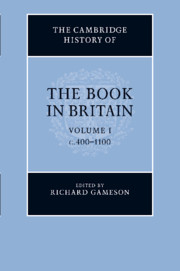Book contents
- Frontmatter
- 1 From Vindolanda to Domesday: the book in Britain from the Romans to the Normans
- PART I THE MAKING OF BOOKS
- 2 The material fabric of early British books
- 3 Anglo-Saxon scribes and scriptoria
- 4 Writing in the Insular world
- 5 Script in Wales, Scotland and Cornwall
- 6 English vernacular script
- 7 Latin script in England c. 900–1100
- 8 The design and decoration of Insular gospel-books and other liturgical manuscripts, c. 600 – c. 900
- 9 The decoration of the earliest Welsh manuscripts
- 10 Book decoration in England, c. 871 – c. 1100
- 11 Bookbindings
- PART II THE CIRCULATION OF BOOKS
- PART III TYPES OF BOOKS AND THEIR USES
- PART IV COLLECTIONS OF BOOKS
- PART V CODA
- Bibliography
- Concordance of named manuscripts
- Index of manuscripts
- General Index
- Plate 4.1: The Lindisfarne Gospels"
- Plate 5.1: The Lichfield/St Chad Gospels"
9 - The decoration of the earliest Welsh manuscripts
from PART I - THE MAKING OF BOOKS
Published online by Cambridge University Press: 28 March 2012
- Frontmatter
- 1 From Vindolanda to Domesday: the book in Britain from the Romans to the Normans
- PART I THE MAKING OF BOOKS
- 2 The material fabric of early British books
- 3 Anglo-Saxon scribes and scriptoria
- 4 Writing in the Insular world
- 5 Script in Wales, Scotland and Cornwall
- 6 English vernacular script
- 7 Latin script in England c. 900–1100
- 8 The design and decoration of Insular gospel-books and other liturgical manuscripts, c. 600 – c. 900
- 9 The decoration of the earliest Welsh manuscripts
- 10 Book decoration in England, c. 871 – c. 1100
- 11 Bookbindings
- PART II THE CIRCULATION OF BOOKS
- PART III TYPES OF BOOKS AND THEIR USES
- PART IV COLLECTIONS OF BOOKS
- PART V CODA
- Bibliography
- Concordance of named manuscripts
- Index of manuscripts
- General Index
- Plate 4.1: The Lindisfarne Gospels"
- Plate 5.1: The Lichfield/St Chad Gospels"
Summary
The fact that so few books can be associated with Wales prior to 1100 means that it is extremely difficult to build up a picture of the artistic capabilities of scribes in the region and of the cultural and religious influences on their output. With the exception of Llanbadarn Fawr towards the end of the period, it is also impossible to identify specific scriptoria with the resources for illuminated manuscript production. However, the illuminated manuscripts that do survive prior to 1100 indicate that art in Wales was firmly within the Insular tradition, an impression confirmed by the growing corpus of stone sculpture and ornamental metalwork.
The earliest illuminated manuscripts that have a definite or possible association with Wales are two gospel-books. The first of these is an incomplete, eighth-century, luxury copy known as the Lichfield Gospels or the Book of St Chad. Where it was produced is unknown, but an early ninth-century Latin addition at the end of St Matthew’s Gospel records that it was bought by Gelhi, son of Arthudd, who ‘gave that Gospel to God on the altar of St Teilo’. The foundation concerned may be identified as Llandeilo Fawr (Carmarthenshire). The beginning of the book, possibly one of two volumes, is missing and it breaks off after Luke 3.9.
Keywords
- Type
- Chapter
- Information
- The Cambridge History of the Book in Britain , pp. 244 - 248Publisher: Cambridge University PressPrint publication year: 2011



